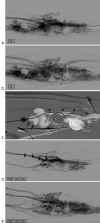Special Consideration for Intraosseous Arteriovenous Malformations
- PMID: 28955116
- PMCID: PMC5615382
- DOI: 10.1055/s-0037-1605368
Special Consideration for Intraosseous Arteriovenous Malformations
Abstract
Intraosseous arteriovenous malformations (AVMs) have been associated with distortion, hypertrophy, osteolytic skeletal changes, bleeding, leg length discrepancy, and pathologic fracture. Computed tomography or magnetic resonance imaging is helpful in the evaluation of the extent and depth of intraosseous AVMs and associated soft-tissue AVMs. Treatment approaches can differ, depending on the angiographic classification. Embolotherapy with ethanol, coils, or n-butyl cyanoacrylate is the primary treatment for symptomatic intraosseous AVMs, and the goal of treatment is symptom improvement with few complications.
Keywords: embolization; embolotherapy; interventional radiology; intraosseous AVM.
Figures








References
-
- Do Y S, Park K B, Park H S et al.Extremity arteriovenous malformations involving the bone: therapeutic outcomes of ethanol embolotherapy. J Vasc Interv Radiol. 2010;21(06):807–816. - PubMed
-
- Savader S J, Savader B L, Otero R R. Intraosseous arteriovenous malformations mimicking malignant disease. Acta Radiol. 1988;29(01):109–114. - PubMed
-
- Boyd J B, Mulliken J B, Kaban L B, Upton J, III, Murray J E. Skeletal changes associated with vascular malformations. Plast Reconstr Surg. 1984;74(06):789–797. - PubMed
-
- Szilagyi D E, Smith R F, Elliott J P, Hageman J H. Congenital arteriovenous anomalies of the limbs. Arch Surg. 1976;111(04):423–429. - PubMed
-
- Flye M W, Jordan B P, Schwartz M Z. Management of congenital arteriovenous malformations. Surgery. 1983;94(05):740–747. - PubMed
Publication types
LinkOut - more resources
Full Text Sources
Other Literature Sources

